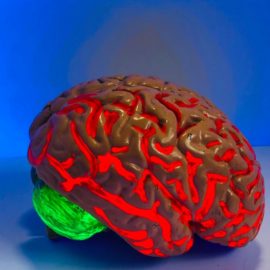

This article is an excerpt from the Shortform book guide to "The Master and His Emissary" by Iain McGilchrist. Shortform has the world's best summaries and analyses of books you should be reading.
Like this article? Sign up for a free trial here.
Why was some religious art destroyed during the Reformation? What’s the evidence that Descartes was left brain dominant? What can we learn from the instances of mental illness in the modern era?
Psychiatrist Iain McGilchrist thinks the right brain hemisphere belongs in control. He points to several historical eras that he says illustrate power imbalances between the hemispheres.
Continue reading to understand how, according to McGilchrist, left hemisphere dominance defined certain eras in history.
Left Hemisphere Primacy in History
In The Master and His Emissary, McGilchrist examines three historical eras that embody the primacy of the right hemisphere: classical antiquity, the Renaissance, and Romanticism. Then, he turns to the eras in which he believes the left hemisphere exhibited too much power. McGilchrist sees this left hemisphere dominance in the Reformation, the Enlightenment, and the Modern and Postmodern world.
First, it’s important to clarify what McGilchrist means when he says that an era can embody hemispheric dominance. He attributes such embodiment to mimesis, a process by which we empathetically imitate certain ways of thinking present in our surroundings. This, he says, leads to functional shifts in our brains and becomes entrenched in different historical eras.
Era #1: The Reformation
The first of these periods—the Reformation—occurred as dissenters left the Roman Catholic Church in 16th-century Europe, spawning Protestantism and its many denominations. McGilchrist points to a rejection of metaphor and implicit meaning in religious art to argue that the left hemisphere exerted excessive power over the right hemisphere throughout the Reformation.
To begin, McGilchrist notes that participants in the Reformation often destroyed religious art, such as paintings of Jesus and even crucifix necklaces. They did so, McGilchrist relates, because they thought these art forms were idolatrous, meaning the art itself was an object of worship. For instance, Reformation theologians might tear down a statue of Jesus out of fear that the statue itself had become the object of adoration rather than Jesus.
(Shortform note: Although Reformed Protestant churches remain relatively common today, these churches rarely endorse the same prohibitions on religious imagery that their intellectual ancestors did. Indeed, one expert notes that most Reformed Protestants don’t view religious imagery as idolatrous, hastening the end of the unadorned Reformed churches of centuries past.)
According to McGilchrist, the rejection of religious imagery stems from an inability to grasp metaphor. He argues that, properly understood, religious art is neither divine nor mundane, but rather a metaphor that points to divinity. However, McGilchrist says, Reformers couldn’t understand this because they didn’t understand metaphor—one of the strengths of the right hemisphere. Moreover, he points out that religious art that wasn’t destroyed was often accompanied by a caption that explained it. For example, a picture of Jesus among the sick might read, “This is Jesus, the Son of God, healing the sick.” This practice, he argues, highlights the left hemisphere’s preference for explicit meaning and its discomfort with the implicit.
(Shortform note: The Reformers offered a different explanation for their disavowal of religious art than a mere inability to understand metaphor. For example, the French Reformer John Calvin argued that religious art necessarily presents a corrupted picture of God, for which reason it should be outlawed. This line of reasoning, along with the scriptural reason McGilchrist cites (that religious art is idolatrous) suggests that the Reformation’s distaste for religious art was rooted in theological commitments. However, it’s possible that these commitments themselves arose from the left hemisphere’s inability to understand metaphor, so this theological explanation isn’t inconsistent with McGilchrist’s explanation.)
Era #2: The Enlightenment
After discussing the Reformation’s religious upheavals, McGilchrist examines the left hemisphere’s influence during the Enlightenment—an intellectual movement in 17th and 18th century Europe that some associate with a rejection of religious dogmas. On the basis of Enlightenment philosophy, he contends that the left hemisphere became too influential during the Enlightenment.
To show as much, McGilchrist focuses largely on the work of René Descartes, a 17th-century French philosopher dubbed the father of modern philosophy, arguing that it showcases several hallmarks of the left hemisphere. As McGilchrist points out, Descartes strove for absolute certainty in his reasoning. In turn, he refused to rely on the intuitive, unreflective thinking associated with the right hemisphere, instead attempting to independently confirm these intuitions.
Moreover, because Descartes wanted to independently verify his intuitions, he took a detached, “objective” stance toward the world that’s neatly aligned with the left hemisphere. However, this detached view of the world led Descartes to abandon even his own bodily experience, leading him to doubt whether he had a body in the first place. Given the right hemisphere’s preference for embodied existence, McGilchrist argues that Descartes shows a right-hemisphere deficit with this doubt.
| Cartesian Epistemology and its Discontents Two features of Descartes’ epistemology—that is, his theory of how we know things about the world—are clearly indicative of the left hemisphere’s influence. First, he argues that our knowledge is grounded on foundational beliefs from which we deduce later beliefs. For example, he might reason as follows: there appears to be a tree outside, and appearances are normally accurate, therefore there is in fact a tree outside. In this respect, Cartesian epistemology tends to disavow the implicit reasoning of the right hemisphere (which simply perceives a tree without reasoning about it) and prefer the explicit reasoning of the left hemisphere. Descartes also argues that knowledge requires infallible evidence—that is, evidence that guarantees the truth of the belief in question. Returning to the above example, he might claim that we don’t know that there’s a tree outside even when we perceive one, because our perceptions are not perfectly accurate. In this respect, Cartesian epistemology shares the left hemisphere’s affinity for absolute certainty. However, this combination of foundational beliefs and the need for certainty causes a problem, since it seems that none of our beliefs are grounded by infallible evidence. For instance, Descartes claims that it’s possible we’re being deceived by an evil demon, such that none of our beliefs are true, and no amount of evidence can rule out this evil-demon hypothesis. For this reason, some philosophers argue that Descartes’ epistemology sets the bar too high since we can’t indisputably guarantee that our beliefs are true, with one exception—Descartes’ famous declaration that he himself exists (“I think, therefore I am”). Seeing the skepticism this leads to, other philosophers endorse epistemological views that are less strict and reflect the right hemisphere’s influence. The Scottish philosopher Thomas Reid, for one, famously defended “common sense epistemology,” which maintains that there are common-sense first principles that we must reasonably accept. For example, even if we can’t prove that we’re not victims of an evil demon, it’s still reasonable to accept that we aren’t being deceived. In this respect, Reid’s common-sense philosophy exalts the right hemisphere’s preference for intuitive thinking over the left hemisphere’s demands for certainty. |
In addition to Descartes, McGilchrist also briefly examines English philosopher Jeremy Bentham, arguing that he too reflects the dominance of the left hemisphere. Bentham, McGilchrist relates, was similarly critical of the intuitions favored by the right hemisphere; instead, he took a logic-driven approach to philosophy that led to utilitarianism, a moral system that evaluates actions solely by the pleasure and pain they created. According to McGilchrist, this unintuitive, mathematical approach to ethics is another clear sign of the left hemisphere.
(Shortform note: Utilitarianism remains a modestly popular view among philosophers, with eminent figures like Peter Singer embracing utilitarianism to defend animal rights, environmental rights, and the importance of charity. However, many utilitarians have shifted from Bentham’s act utilitarianism, which says that in each individual case, we should act in such a way to maximize pleasure and minimize pain, toward rule utilitarianism, which says that we should act in accordance with general rules that collectively maximize pleasure and minimize pain.)
Era #3: The Modern and Postmodern World
After outlining the left hemisphere’s role in the Enlightenment, McGilchrist concludes by discussing the progression from Modernity to Postmodernism around the mid-20th century. Pointing to modernist art, the postmodernist failure to grasp linguistic meaning, and recent rises in certain forms of mental illness, McGilchrist argues that the left hemisphere has again gained undue influence over the right hemisphere.
First, McGilchrist points out that modern art severed the connection between art and the external world, with critics praising the value of “art for art’s sake.” In turn, he says, art grew alienated from the world, leading to abstract artworks that lacked context—exactly what the left hemisphere prefers. According to McGilchrist, this trend yielded several artistic movements that further illustrated the left hemisphere’s influence. For example, pointillism reduced coherent wholes to the sum of individual parts, reflecting the left hemisphere’s inability to see wholes as greater than their parts.
(Shortform note: Around the 1970s, modernism in art gave way to the postmodernist art movement that took modernist ideas a step further. Experts note that postmodernist art reflected a commitment to poststructuralism, the view that traditional structures (within art, but also within literature) were inessential, meaning they could be abandoned. In turn, postmodernist art attempted to liberate itself from these structures, leaving little in the way of common standards that unite and define art.)
Next, McGilchrist argues that postmodernist views on language also demonstrate the left hemisphere’s primacy. He notes that, in postmodernism, the notion that words correspond to objects in the external world—for example, that the word “spoon” corresponds to spoons—is lost, along with the notion that language can express truths about the external world. As a result, postmodernist views on language fail to grasp the meaning it conveys, instead focusing on the formal structure of language itself—a formal system that is in the left hemisphere’s wheelhouse.
(Shortform note: Though McGilchrist treats postmodernism as a unified movement, experts typically contend that postmodernism doesn’t admit a single, unequivocal definition. By contrast, they argue that it’s useful to instead view postmodernism as the denial of many modernist commitments. For example, postmodernists deny the possibility of certainty pursued by Enlightenment-era scientists, and likewise deny the notion of a coherent self that persists across time.)
Finally, McGilchrist cites a rise in mental illnesses associated with right hemisphere deficits as evidence for the left hemisphere’s primacy in the modern world. He points out that schizophrenia became much more common in Western countries during the early 1900s, with symptoms of schizophrenia suggesting severe right hemisphere deficits. For instance, schizophrenics struggle to understand implicit meaning, empathize with others, and grasp whole forms rather than their individual parts.
(Shortform note: As a brain disease, schizophrenia is unique in that it manifests differently depending on the culture that you live in. For example, experts point out that in the West, schizophrenia is associated more heavily with feelings of depression and a lack of control, whereas in Eastern cultures schizophrenics experience higher rates of auditory and visual hallucinations.)

———End of Preview———
Like what you just read? Read the rest of the world's best book summary and analysis of Iain McGilchrist's "The Master and His Emissary" at Shortform.
Here's what you'll find in our full The Master and His Emissary summary:
- How pop psychology has given us the wrong impressions of the brain's hemispheres
- Why the right hemisphere is actually more important than the left
- What would happen if left-hemisphere thinking took over the world






